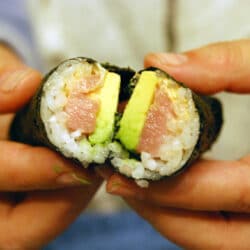Interesting Sushi Facts
Fun And Interesting Sushi Facts

There are many facts about sushi that don’t quite fit in the normal FAQ area that are still, in my opinion, interesting enough to warrant being included in this webpage. On this page is a collection of interesting tid-bits about sushi, sashimi, maki, and related Japanese food that seem to fit perfectly together without being explained. This is not a traditional FAQ, but a collection of notable points that hopefully will get the reader thinking, and hopefully hungry for more. Keep coming back as this page will continually be updated with new factoids to spark sushi fanaticisms and make you see sushi in a whole new light.
- Not long ago, a sushi chef (itamae) had to undergo ten years of training before working in a restaurant. Today, demand for these skilled food artists is so high that many start work after only two years of training.
- Approximately 80% of the world’s bluefin tuna catch is used for sushi.
- Sushi dates back to at least the second century A.D., beginning as a method of preserving fish in China. See our “The History of Sushi” page for more details about sushi history.
- Nearly half the fish consumed as food worldwide are raised on fish farms rather than caught in the wild, according to the Food and Agriculture Organization of the United Nations.
- Japan’s Agriculture Ministry has set up a panel to discuss a certification system for Japanese restaurants abroad. Possible gastronomic crimes include slicing fish too thick, using too little or too much wasabi and over-boiling rice. Japanese tourists have also been known to complain about greasy tempura, floppy, lifeless noodles and seaweed that is not crispy enough. The ministry said its aim was to “spread correct Japanese gastronomic culture” and “improve the reliability of our country’s food” in foreign countries.
- The highest price ever paid for a sushi grade Bluefin Tuna was $396,000 for a 754 pound fish ($526/lb) on January 4th, 2011 at the Tsukiji Fish Market in Tokyo. What makes this more interesting is that this record was 10 years to the day as the last record. Previously, the highest price ever paid for a sushi grade Bluefin Tuna was $173,600 for a 444 pound fish ($391/lb) on January 5th, 2001.
- The United States Food and Drug Administration stipulates that all fish to be eaten raw (with the exception of tuna) must be frozen first, in order to kill parasites.
